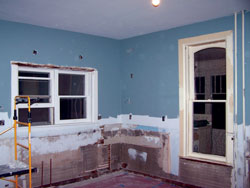WASHINGTON—While a portion of the 2008 Lead Renovation, Repair, and Painting Program (RRP) has been in effect since December 2008, as of April 22, the Environmental Protection Agency’s (EPA) final Rule, referred to as the “RRP Rule,” has taken effect.
One of the chief requirements of this new federal regulation is that anyone, including flooring installers, involved in construction related activity that impacts six square feet or more in total (Editor’s note: some states are using two square feet) of any
and all surface coatings (paint, stain, varnish, etc.) or lead-contaminating materials in a pre- 1978 structure—as well as all commercial daycare centers and kindergarten facilities—must receive the mandated Lead-Safe Work Practices (LSWP) training from an approved professional training provider. The law applies to interior renovations.
According to the rule, a state or EPA certification/license will be required for construction-related activity. The training must be received from an approved professional, meaning that person has been accredited by the EPA or by the specific state in which the person wants to provide services.
Contractors are now required to give property owners/occupants the EPA pamphlet, “Renovate Right: Important Lead Hazard Information for Families, Child Care Providers and Schools” before starting work on pre-1978 housing and child-occupied facilities.
Also part of the new rule, contractors must document their compliance with the requirement and keep a record of it for three years; a pre-renovation disclosure form is available at epa.gov.
“With this deadline,” said Christopher Davis, president and CEO of the World Floor Covering Association (WFCA), “it is more important than ever that any WFCA members involved in renovations, including dealers, contractors, installers, inspectors, cleaners and restoration companies, be aware of, and be in compliance with the new rules.”
Essentially, RPP mandates if anyone is going to be disturbing the surfaces, such as refinished flooring surfaces in pre-1978 constructed structures, as noted in the rule there are certain procedures that must be followed, including being certified to work on such a project or they could be subject to substantial federal penalties under the Toxic Substances Control Act.
While the flooring industry was not the primary target of this new Lead Paint Renovation, Repair and Painting regulation and certification program, Davis noted, “We have managed to be swept into the tide. We sent a bulletin on this subject to WFCA members on March 9, written by our general counsel, Jeff King, which spells out the program in great detail.”
He explained WFCA sent out the bulletin because as with most federal regulations, this is a mandatory program requiring compliance. “Anyone who chooses not to go through the EPA-specified certification program and performs this type of work does so at his own risk and peril.” Industry reaction to RPP has been mixed. While all believe the lead issue needs to be addressed, many don’t agree with the way the ruling goes about it.
According to industry veteran Dave Stafford of Dave Stafford Associates, “This reminds me of the move in the late 1980s, early 1990s to completely regulate the removal of asbestos containing flooring materials. This caused hysterical reactions among certain flooring segments, added another layer of cost for the dealer/installer, and spawned a great niche business for others.”
While Stafford agrees lead is bad, he questions if this regulatory effort is really going to accomplish that much. “Maybe, maybe not. Perhaps this is just another new mission focus for the EPA.”
There has been little or no publicity on the RRP Rules, he added, “so I doubt most flooring dealers, installers and contractors can be effectively in compliance anytime soon. I predict some larger dealers will just sub this type of work out to a company that specializes in it. The main reason will be the potential liability.
“During the asbestos removal era,” Stafford continued, “more than one large dealer took a look at the skyrocketing insurance rates and lack of meaningful coverage and said, ‘We just have too much to lose to do this business, so we’ll just pass this along to a small company willing to take the risk.’
Jim Walker, CEO of the International Certified Floorcovering Installers Association (CFI), agreed with Stafford’s comparison about RPP and asbestos, as well as the fact not much information has been made available concerning the rule and flooring. “We do agree that each company should have someone certified and available to train others. We are advising our members through our association with WFCA to obtain certification for their protection and that of others. However, from every course we have received comments on so far, none even minimally address flooring issues. They are expensive for the average installer and they receive the certification, but not the knowledge that is critical for the trade. It is important to investigate the topics that are offered prior to attending the course.”
Stafford feels the EPA “will almost certainly” make examples “of some unlucky dealers/con- tractors/installers for training, paperwork and notice violations, and be a boon for the legal profession and the trainers who charge for teaching the course work. I hope this limiting of lead exposure will be worth the financial agony that accompanies such a new government regulation.”
Two pamphlets designed to help contractors comply with the new rules, “Small Entity Compliance Guide to Renovate Right” and “Lead Safety During Renovation,” are available for free at the EPA’s website. The agency recommends anyone disturbing lead paint follow lead-safe work practices, such as containing the work area, minimizing dust, and cleaning up thoroughly.
